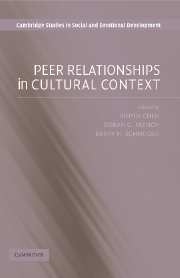Book contents
- Frontmatter
- Contents
- List of Contributors
- Introduction
- Part I Culture and Peer Relationships: Theoretical and Methodological Issues
- Part II Temperamental and Emotional Influences on Peer Relationships
- Part III Peers and Parents
- Part IV Peer Interactions and Social Behaviors
- Part V Friendships
- 17 Friendships of Indonesian, South Korean, and U.S. Youth: Exclusivity, Intimacy, Enhancement of Worth, and Conflict
- 18 The Cultural Practice of Close Friendships Among Urban Adolescents in the United States
- 19 Latino-Heritage Adolescents' Friendships
- 20 The Cultural Context of Children and Adolescents: Peer Relationships and Intimate Friendships Among Arab and Jewish Children in Israel
- Commentary III
- Conclusion
- Author Index
- Subject Index
- References
19 - Latino-Heritage Adolescents' Friendships
from Part V - Friendships
Published online by Cambridge University Press: 08 August 2009
- Frontmatter
- Contents
- List of Contributors
- Introduction
- Part I Culture and Peer Relationships: Theoretical and Methodological Issues
- Part II Temperamental and Emotional Influences on Peer Relationships
- Part III Peers and Parents
- Part IV Peer Interactions and Social Behaviors
- Part V Friendships
- 17 Friendships of Indonesian, South Korean, and U.S. Youth: Exclusivity, Intimacy, Enhancement of Worth, and Conflict
- 18 The Cultural Practice of Close Friendships Among Urban Adolescents in the United States
- 19 Latino-Heritage Adolescents' Friendships
- 20 The Cultural Context of Children and Adolescents: Peer Relationships and Intimate Friendships Among Arab and Jewish Children in Israel
- Commentary III
- Conclusion
- Author Index
- Subject Index
- References
Summary
In the last few decades, culture has taken center stage in developmental psychology. Increased attention to culture has led to lively debates not only about the meanings and nuances of culture, but also about the meanings and nuances of ethnicity, gender, class, and other aspects of culture that play a role in development. Two of the issues under debate that have influenced our research on Latino-heritage adolescents' friendships are (a) whether and how universal and culture-specific developmental processes and outcomes can be identified and (b) how these potential universal and culture-specific processes and outcomes can be explained and integrated in developmental theory and research. In this chapter, we focus on ethnicity and how this aspect of culture contextualizes the friendships of Latino-heritage adolescents living in the United States.
Identifying, describing, and explaining between and within ethnic group similarities and variations in developmental processes and outcomes has been challenging because culture and ethnicity are fuzzy, contextual, and fluid constructs (Betancourt & Lopez, 1993; Gjerde, 2004; Phinney & Landin, 1998). Yet, we want to use our research to draw some conclusions and build theories that contain some general statements about these between- and within-cultural similarities and variations. In attempting to attain these goals, we have tried to avoid falling prey to using culture or ethnicity as empty, overgeneralizing, stereotyping concepts that lead us to construct developmental stories and theories that apply to no one in the cultural communities we are studying.
- Type
- Chapter
- Information
- Peer Relationships in Cultural Context , pp. 426 - 451Publisher: Cambridge University PressPrint publication year: 2006
References
- 9
- Cited by

